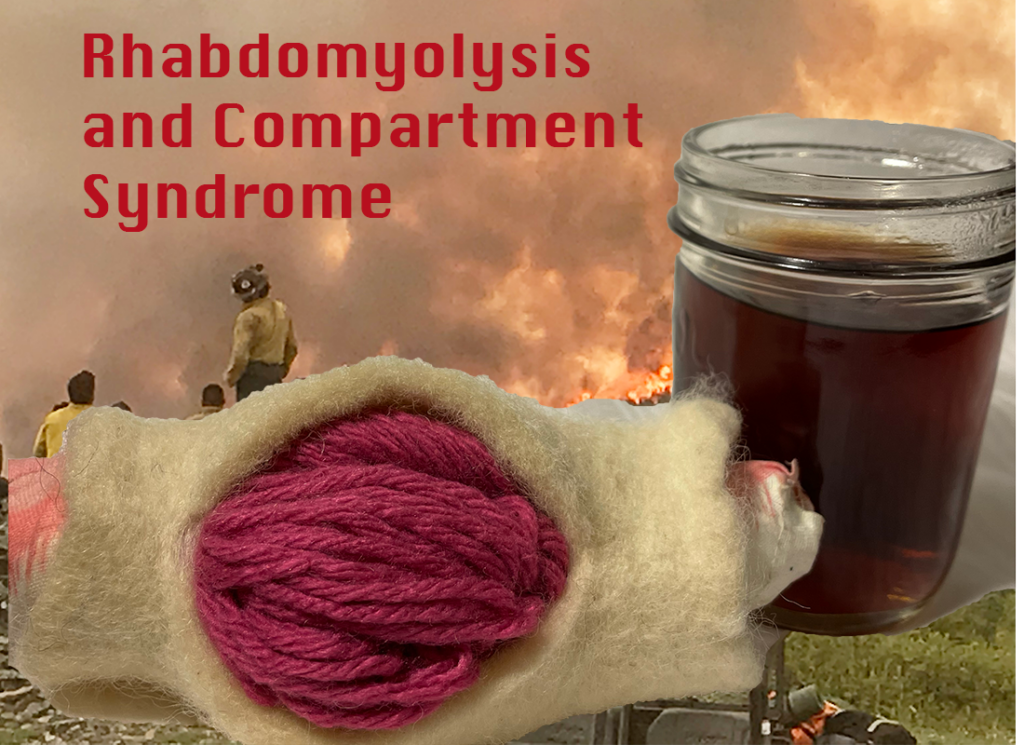For my STEAM project I will be looking at exercise induced rhabdomyolysis (exRML) and compartment syndrome. Exercise induced rhabdomyolysis is a pathophysiological condition of the skeletal muscle system that can cause acute renal failure and in some cases death. The class objectives related to this are: 1.) know the different energy molecules in the cell and their use in anaerobic and aerobic exercise. 2.) describe how a muscle contraction is induced. These objectives pertain because exRML is caused by and increase of Ca2+ levels in cells because of the depletion of adenosine triphosphate (ATP).
Rhabdomyolysis and compartment syndrome was first recognized in1940-1941 in patients with crush injuries caused by building destruction during World War II. It is most commonly found in crush and burn injuries where the muscle has been directly injured but other causes of RML have also been recognized including toxins, endocrinopathies, malignant hyperthermia, the medical conditions and overexertion. I am going to be focusing specifically on overexertion or exercise induces RML for my steam project.
Ca2+ has an important role in the Pathogenesis of exRML. Numerous studies have shown an increased level of Ca2+ in patients with exRML. Increased Ca2+ has been reported in the sarcoplasm of exRML patients with deficiency or depletion of ATP due to intensity of exercise. ATP is continually produced during exercise and when ATP is depleted ATP-dependent ion transporters may be affected. The increase of Na+ and K+ that happen when there is an action potential is dependent of ATP so when there is not enough ATP it can cause a disfunction of the Na+ – K+ ATPase resulting in increased levels of Na+ which causes the cell to produce more Ca2+ and this disfunction of the Ca2+ pump is what they think causes RML. The increased level of Ca2+ damages the phospholipids of the cell membrane which causes toxicity to the cell and cell death. Death of muscular tissues may create additional space for increased accumulation of intravascular fluid which causes compartment syndrome. And the toxicity of the blood enters the circular system and can cause renal failure and death.
I read a number of case studies one where a Soldier got fatal exRML with Compartment syndrome in both legs after an Army physical fitness test and another where a number of high school football players developed exRML and triceps compartment syndrome following an upper arm exercise. From 2008 to 2015 19 confirmed cases of exRML were reported in wildland firefighters with five of those cases developing into compartment syndrome. It became such an important issue in wildland fire that the U.S. Forest service issued an eighteen page report just on the issue.
For my STEAM project I made a model of a lower leg made of wet felted wool and yarn showing a leg with compartment syndrome. When a patient develops compartment syndrome, besides aggressive fluid therapy, the patient may require a deep fasciotomy to open the compartments and relieve the pressure that is reducing circulation in the leg. In my model you can see the fasciotomy and the swelling of the muscles that is caused by RML. Symptoms of exRML include muscle pain developing hours after exercise peaking between 24 to 48 hours post exercise, cramping, swelling, weakness, stiffness and decreased range-of-motion, nausea or vomiting, fever, rapid hear rate, confusion or lack of consciousness, and tea or Coca-Cola colored urine. I also included in my model a glass of dark urine to remind people of one of the most common sign of RML. Heat stress and heat stroke are possible contributing factors of RML as well as the use of dietary supplements such as creatine snd hydroxycut. Creatine in particular which is used by many weight lifters has been found to be a major risk factor.
Bibliography
Coban, Y. K. (2014). Rhabdomyolysis, compartment syndrome and thermal injury. World Journal of Critical Care Medicine, 3(1), 1–7. https://doi.org/10.5492/wjccm.v3.i1.
Kim, J., Lee, J., Kim, S., Ryu, H. Y., Cha, K. S., & Sung, D. J. (2016). Exercise-induced rhabdomyolysis mechanisms and prevention: A literature review. Journal of Sport and Health Science, 5(3), 324–333. https://doi.org/10.1016/j.jshs.2015.01.012
Kuklo, T. R., Tis, J. E., Moores, L. K., & Schaefer, R. A. (2000). Fatal rhabdomyolysis with bilateral gluteal, thigh, and leg compartment syndrome after the Army Physical Fitness Test. The American Journal of Sports Medicine, 28(1), 112–116. https://doi.org/10.1177/03635465000280010401
Minnema, B. J., Neligan, P. C., Quraishi, N. A., Fehlings, M. G., & Prakash, S. (2008). A case of occult compartment syndrome and nonresolving rhabdomyolysis. Journal of General Internal Medicine, 23(6), 871–874. https://doi.org/10.1007/s11606-008-0569-1
Oh, J. Y., Laidler, M., Fiala, S. C., & Hedberg, K. (2011). Acute exertional rhabdomyolysis and triceps compartment syndrome during a high school football camp. Sports Health: A Multidisciplinary Approach, 4(1), 57–62. https://doi.org/10.1177/1941738111413874
West, M., Domitrovich, J., & Symonds, J. (2018). Rhabdomyolysis in Wildland Fire A review of reported cases. Wildfire Today. Retrieved November 22, 2022, from https://wildfiretoday.com/docs/Rhabdo_5_9_16.pdf


